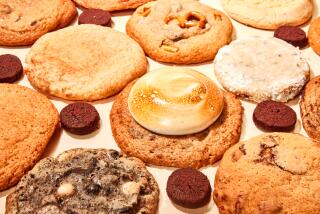‘Poilâne,’ Apollonia Poilâne’s first cookbook in English, is a quarantine baker’s perfect bread handbook
While many of us are stuck at home, with time to read as we compulsively stress-bake and feed our sourdough starters, may I make a suggestion? Get a copy of French baker Apollonia Poilâne‘s cookbook, which will happily address your baking concerns as well as what to do with all that bread.
“Poilâne: The Secrets of the World-Famous Bread Bakery” came out in October and is the first book in English from Poilâne, the granddaughter of Pierre Poilâne, who opened the family bakery in 1932 on the Left Bank in Paris. If you readthe New Yorker, you may already know her story: how her parents died in a 2002 helicopter crash, when she was a teenager, leaving her to run the family business — from her Harvard dorm room.
Not only did she take the helm of the company and graduate with a degree in economics but she and her younger sister, Athena, have also expanded and modernized the boulangerie. (There are bakeries now in Paris and London, and you can order Poilâne’s bread, flour, bannetons and filled cookie tins online, even shipped overnight to California.)
After a forward by Alice Waters, the first recipe is, of course, for the sourdough boule that made the bakery famous. (I once walked across Paris to get one of the massive loaves, engraved with the swirled letter P, the size and shape of a Citroën hubcap.) Apollonia Poilâne takes you through the process, which includes making starter from scratch (she uses yogurt), proofing, shaping, scoring and baking (in a 12-inch lidded Dutch oven).
Poilâne is a patient teacher, taking novice bakers through the steps, providing encouragement for instructions that many might find daunting, and including marvelous tips on technique, flours, “baking with all your senses” and stories about growing up and learning how to bake herself.
More surprising, however, is that this is not a wonky book, written by one master baker for other master bakers. Rather it’s a gentle, user-friendly cookbook that provides recipes which are sometimes utterly, beautifully simple. Sure, you’ll find stuff on decorative flourishes and laminating dough, but this book is also a paean to loaves and even single slices of bread.
There are also wonderfully useful tips for storing and refreshing bread, what to do with stale bread (make ice cream), where to find baking gear (directly from Poilâne) and how to make good croutons (spice and fry them). The thick catalog of recipes includes as many for what to do with your bread as for the breads themselves, such as bread chips, bread granola, whipped cream made with cream steeped in brioche, simple dishes made with all those bread crumbs and a recipe for, yes, perfect toast.
“A recipe for toast? You many scoff,” she writes. “But my father was onto something with a little trick he had.” (Spoiler: You toast the bread in pairs.) And so the pages accumulate, shuffling recipes for crouton salads, meatloaf (made with bread crumbs) and bread-and-butter sandwiches with more elaborate chef-y ones for croissants, puff pastry and a massive, intricate galette des rois. The range is spectacular and often playful, with welcome accompanying recipes such as those for oat milk, cultured butter and flavored jams.
This is a pragmatic book about the most basic, even profound, of all staple foods, a fitting read for a time when we have actual bread lines again. Unlike many bread books, which can often read like graduate-level chemistry texts, “Poilâne” is equally useful for both practiced bakers and neophytes tentatively kneading their first loaves. It is also a cookbook that you can treat like a quarantine coffee-table book, paging through the terrific photography (by Philippe Vaurès Santamaria), dreaming of a post-pandemic trip to Europe.
“Once, when we were kids, my father brought me and my sister to an abandoned malt factory outside Antwerp, Belgium,” Poilâne writes in the head note to a recipe for barley-beer bread, like she’s telling a fairy tale in her kitchen.
“He led us through a trapdoor into an old empty grain silo and told us to rub the wall with our fingers to bring out the barley aroma that had been trapped in the wall for decades. Sure enough we could smell, however faintly, the toasted cereal scent, and we marveled at how we could conjure up the past just like that.”
More to Read
Eat your way across L.A.
Get our weekly Tasting Notes newsletter for reviews, news and more.
You may occasionally receive promotional content from the Los Angeles Times.











